Top 15 Myths about Snakes
High-Yellow Sorong Amethystine Scrub Python
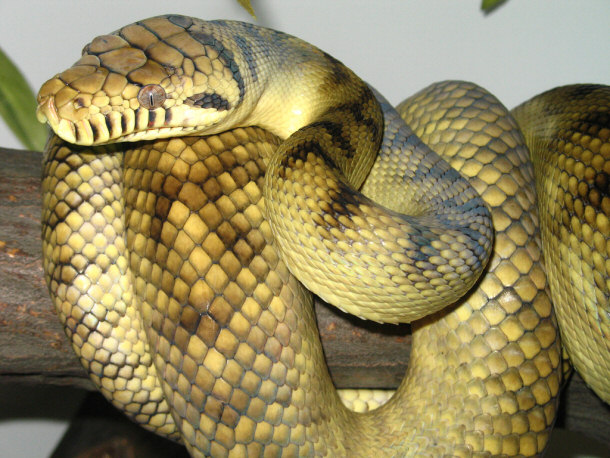
By Mike
via Wikimedia Commons
Theyíre covered in scales, they can be aggressive and dangerous, and are downright
scary to many people. Snakes never had a large fanbase and that shows in the
number of negative stories that are spread about them. Every time a negative
encounter with a snake is retold, more fear is generated about them. Ophidiophobia,
commonly known as a crippling fear of snakes, is one of the most common animal
fears. It may seem ridiculous, at least to those unfamiliar with clinically diagnosed
phobias, when someone suffering from ophidiophobia runs out of the room after
simply seeing an image of a snake. This fear does have a sensible root.
Evolution has done its best to keep a healthy fear of snakes a part of human
nature, making sure overly curious humans donít start doing something stupid in
the presence of a potentially deadly animal. The problem is that a majority of
people really do something incredibly stupid due mostly because of the following 15 snake myths.
Myth 15) When Confronted, Run Like Hell
Thankfully, this myth isnít too widespread since it is simply the wrong thing to
do. Letting natural instinct cloud your better
judgment almost always ends badly. Itís absolutely natural, if youíre not used to
handling snakes regularly, to have a racing heart when you finally have a
face-off with a snake. Youíve certainly heard this line before, but the truth is
that the snake will be
more afraid of you than you are of it. From an animalistic point of view anything
that is several times larger than the animal in question is a threat to its
survival, simply because of the size advantage. So when youíre facing a snake
you donít have to worry about it biting you, as long as you donít give it any reason to
feel so threatened that it needs to get a strike in.
Rattlesnake Bite
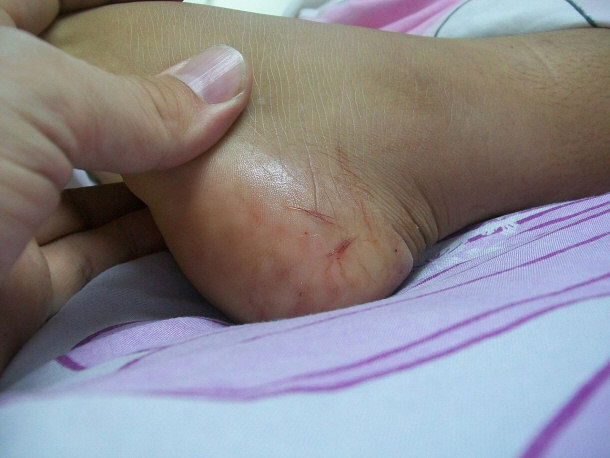
By Bobjgalindo
via Wikimedia Commons
The first thing you should do is to not make any sudden movements. Keep the snake in your sight and slowly move
backwards until you are far enough away that youíre beyond the normal striking
range of the snake. This would be a third of its body length when itís upright. Out
of range, you can walk a bit faster until youíre back on safe ground. You
neednít worry about the animal possibly giving chase once you start walking
away. The snake will be content knowing that it doesnít have to bother fighting
you, and that it has avoided putting its own
life in danger in the process.
Myth 14) Snakes Are Slimy and Feel Clammy
This is a classic snake myth. It's very likely that itís the first snake myth
youíve ever heard, since itís something children will loudly proclaim when
reptiles come up in conversation. Itís quite possible that this myth can be
sourced back to the visual similarity between snails and slugs to snakes. Both
of these
animals do not use limbs to provide forward motion. Snails and slugs glide on self-produced slime to ease their travel
and are accordingly, slimy and clammy.
Snake Skin
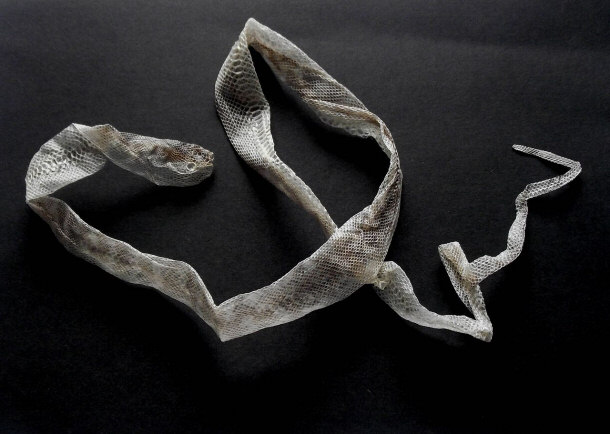
By Malcolm Lidbury (aka Pinkpasty),
via Wikimedia Commons
Snakes, on the other hand, have
completely dry and smooth skin. Besides lacking in the damp and slimy
department, the body temperature of snakes is highly dependent on the
surroundings they are found in.
Snakes are poikilothermic, meaning that they are cold-blooded and need a source
of warmth to raise their body temperature.
Myth 13) The Question of Two-Headed Snakes
This myth sounds a lot like a really bad horror movie: A potentially deadly
animal with not one, but two heads to be worried about. In truth, the possibility of you encountering a two-headed snake in the
wild is as good as none. A two-headed snake would never survive in the wild, because
it would constantly sabotage its own existence. These animals are more like
conjoined twins, though in this specific case the twins will be constantly at
each otherís throats.
Two-headed Snake in Captivity
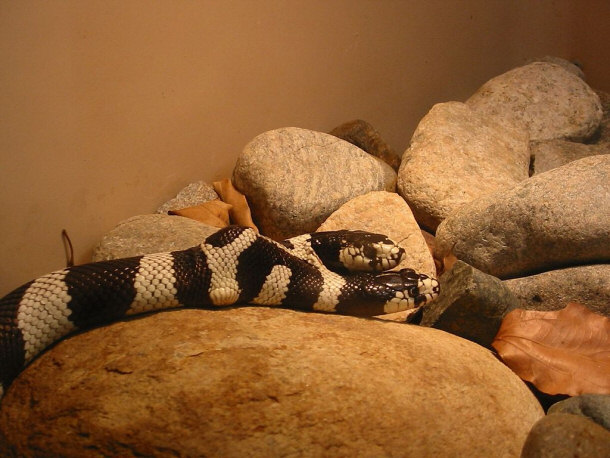
By Zach Tirrell from Plymouth, USA,
via Wikimedia Commons
Two-headed snakes have to deal with two sensory inputs in
terms of 'hearing', smelling, and seeing all while sharing one body. Still,
they have the same instinctual drive to survive implanted in each head. When
faced with prey, each head will aim to hunt it individually. The result is each
snake head killing the other in the struggle for survival..
Myth 12) Snakes Can't Fly
The thought that this could be true is absolutely terrifying. However, to ease your fears a bit, snakes really canít fly
in the strict definition of the word. What they really do is glide.
It has been observed in Sri Lanka and several Southeast Asian countries, and
there are five tree-dwelling snake species that have perfected their adaptation
to their surroundings. After dropping from a high branch or swinging into the
air, these snakes widen their ribs, flattening their bodies and creating more
air resistance. By adding S-shaped movements, the reptiles slow their fall and
create a little bit of forward momentum.
Flying Snake - Chrysopelea
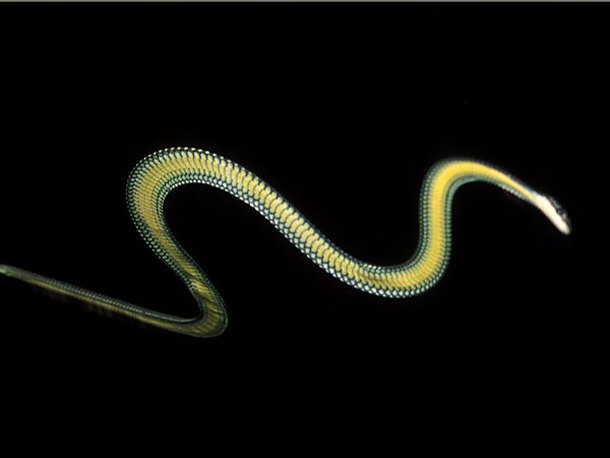
Photo by Jake Socha
Besides possibly giving any unsuspecting person
on a jungle trek the fright of their lives, the motivation for this behavior is
incredibly simple. Birds and monkeys are part of the menu for a tree-dwelling
snakeís diet. Since these animals can be incredibly hard to catch, evolution just evened the
odds a bit for the flying snake.
Myth 11) All Snakes Lay Eggs
Reptiles lay eggs and it should be as simple to believe that all snakes lay eggs. However, only 70 percent of the entire worldís snakes lay
and breed eggs. The remaining 30 percent are mainly made up of the members of
the boa and viper families, and these subspecies give birth to live young. The
reason is simply due to biological factors.
Corn Snake Hatching
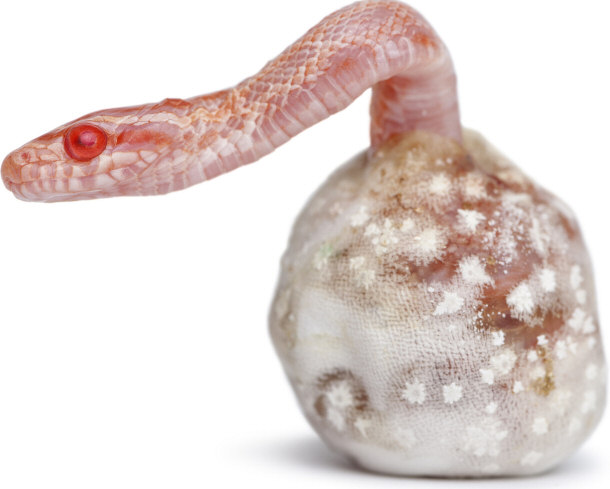
Snakes in warmer regions can afford
laying eggs in the ground, since its warm enough thanks to the ambient
temperature of their surroundings. Species living in colder regions or regions where temperatures are
prone to extreme fluctuations, would risk the death of their hatchlings to the
colder temperatures. Live birth is
crucial to the survival of these species.
Myth 10) Recognizing a Poisonous Snake
Another common misconception is how to tell a poisonous snake from a
constrictor. According to this myth, poisonous snakes all have triangular heads
and are brightly colored. If youíre familiar with the concept of mimicry, youíll
recognize the problem. Some animals just pretend to be poisonous to discourage
predators, by having bright coloring or imitating the shape or looks of a
dangerous animal. So there are constrictor snakes with triangular heads just as
there are poisonous snakes that donít have triangular heads. A good example of how color
cannot indicate if an animal is capable of giving off any kind of venom would be
the milk snake. This breed is loved by keepers and breeders for their red, white
or yellow and black stripes. This makes milk snakes easy to handle with no fear
of a
poisonous bite. Some literature on keeping snakes as pets even indicates that milk snakes can be considered a beginner's pet.
In the wonder of mimicry, their poisonous companion that they mimic is the coral
snake.
Milk Snake
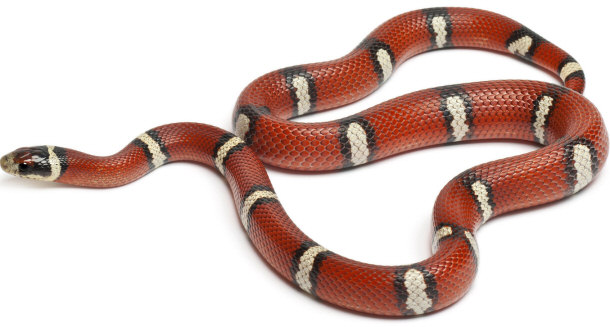
Eastern Coral Snake
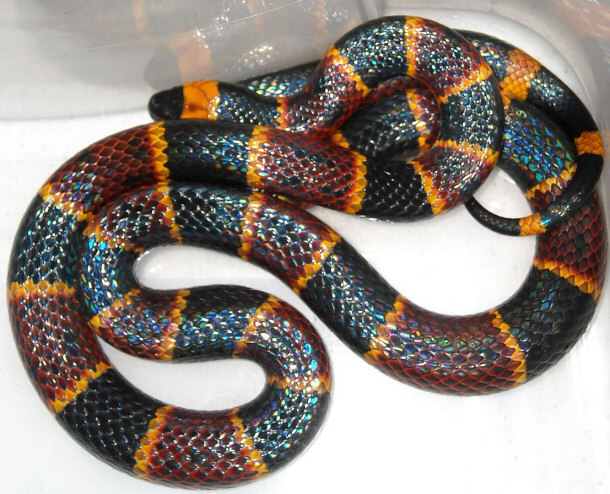
By Norman.benton
via Wikimedia Commons
It makes no sense for a poisonous snake to announce to its prey that it is
present. Accordingly, to make
hunting easier most poisonous snakes like vipers, have earthy colors and
patterns. This allows them to blend in with their surroundings in stone deserts and
among the undergrowth. Tree-dwelling snakes are often intense green in
color, which allow them to blend in the tropical habitats that they usually live in. Unusual
colors are commonly only found in snakes that have been bred in captivity. These
animals have little to no survival chances in the wild.
Myth 9) Counting Rattlesnake Years
According to myth you can count the age of a rattlesnake by the number of
rattles it has on its tail, with one rattle counting as a year. This myth is an
exaggeration of the truth. Rattlesnakes add a rattle with every molting, which
is the term for when a snake sheds. Like every other snake, the skin doesnít
grow along with the body, so it has to be removed regularly to allow for more
space to grow.
Southern Pacific Rattlesnake
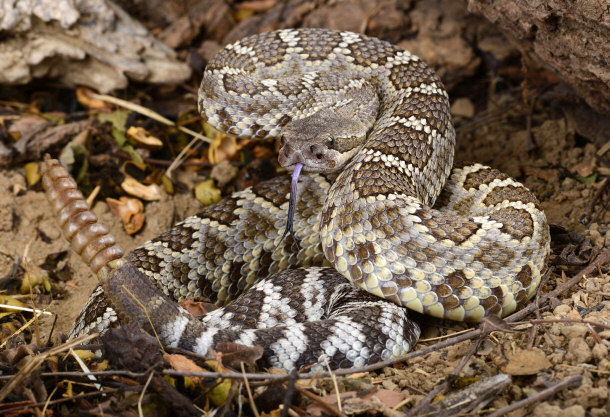
Molting is done more than once a year and usually takes place in a timeframe
of 14 days. This process is repeated every few days or months, depending on how
old and well fed the animal is. During the first nine years of a snake's life, snakes grow quickly
until they reach their maturity just like every other animal. After that, they
donít stop in their growth, but rather it is slowed down greatly.
Myth 8) Snakes Drink Milk
Because snakes have and still are often found in barns occupied by other
animals, the myth that some snakes enter farms to drink milk from cows, goats,
and sheep began to spread. What the reptiles are actually doing in these
agricultural
structures is far more beneficial to most owners, even if they refuse to
acknowledge it at first. Besides the large mammals that these structures were
intended for, barns house all kinds of vermin. That means for a snake, a barn is pretty much the Land of Cockaigne.
Unless a snake is suffering from extreme dehydration and thereís nothing else to
drink but milk, no species of snake will drink it. These animals donít produce
milk for their young, so itís unlikely that snakes biologically need the
components contained in milk or the metabolic necessities to digest it. What
makes this myth even more unlikely is the fact that venomous snakes canít even
suck milk without poisoning its target animal. Constrictor snakes have tiny backward curved teeth that can hook into the udder
of a mammal, causing it pain.
Yellow Rat Snake
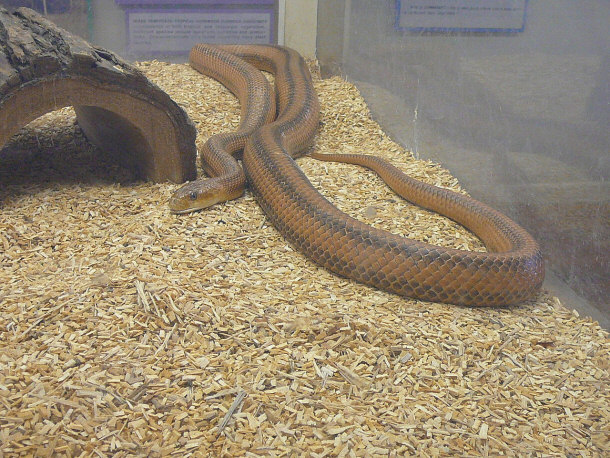
By Cary Bass
via Wikimedia Commons
No animal will just remain calmly standing, letting any
snake try and suck their milk.
Myth 7) Snakes Only Strike When Coiled
If every threatened snake takes the time to coil first before going in for a
strike, the reptile wouldnít be perceived as such an extreme threat. The coiling
would be a simple way to recognize the moment before a strike, so backing off in
time will be much easier.
Bothrops asper

By caspar s
via Wikimedia Commons
Even though a lot of snakes will
coil or take on S shape before biting, this action only increases the distance
they can reach. Never mind the fact that a snake can sense you coming long
before you even reach it, by assessing the vibrations your movements create and
send through the ground.
Necrotic Aftermath of a Bothrops asper Bite on a
11-year-old Boy
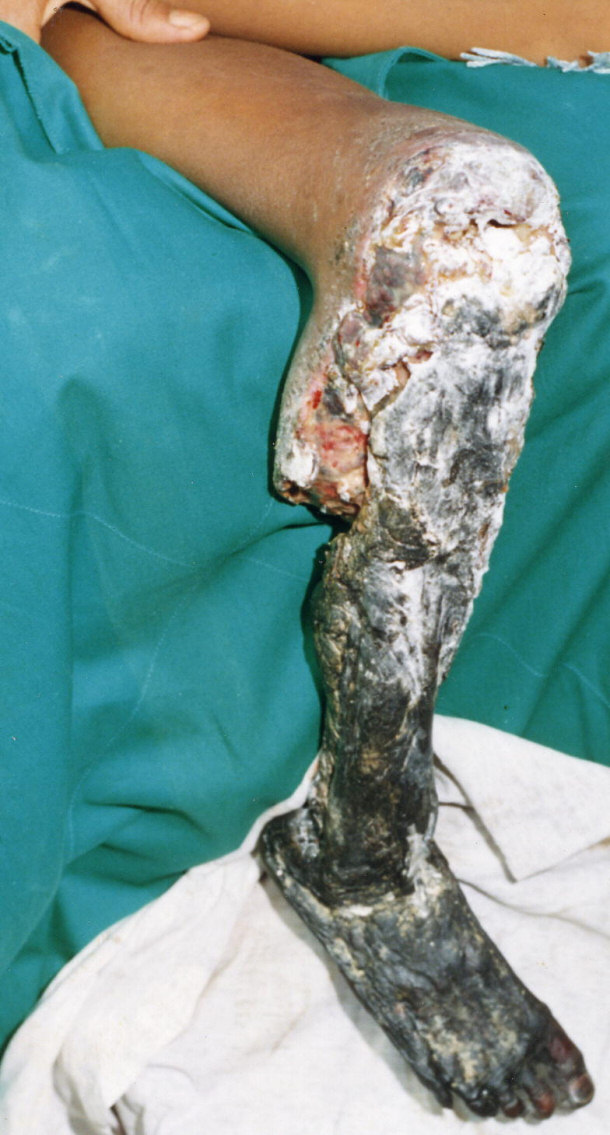
By D.A. Warrell
via Wikimedia Commons
Trying to pick up a snake from behind - though why ever you would want to do
that if youíre not a researcher, biologist or someone who knows exactly what
theyíre doing - in hopes of avoiding a bite is a
really bad idea.
Myth 6) Hoop Snakes
This myth sounds adorably absurd, and it's hard to believe that this myth
has managed to survive this long. There are still regularly reported
sightings of the so-called hoop snake, rolling away just like a wheel. According
to the myth, the hoop snake bites its tail and rolls away when it feels it is in
danger. In some other myths, it even does this to hunt down prey faster. There
are several potential sources for this myth.
Ouroboros Drawing from Late Medieval Byzantine Greek
Manuscript

One could be the ouroboros, which is an ancient symbol of a dragon or serpent
biting its own tail. The ouroboros is found in many cultures around the
world (for example ancient Mayan, Roman, and Greek culture). Another would be a related animal that really does bite its own tail to
protect itself, and roll away from danger.
Armadillo Girdled Lizard
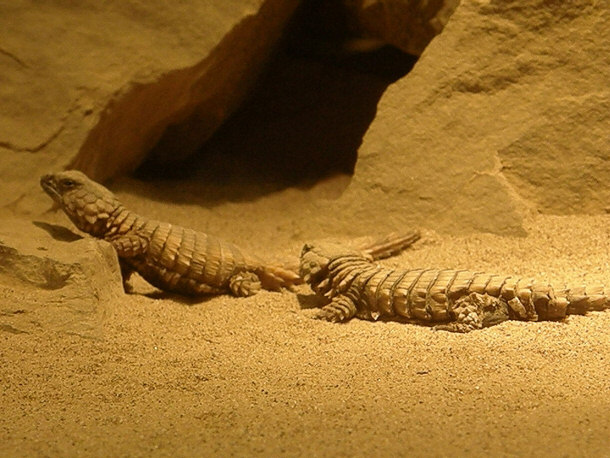
By Frank Wouters
via Wikimedia Commons
The armadillo girdled lizard lives in
desert-like regions, and its body is made up of several sharp scales that make
it an unattractive prey.
Gnostic Gem with Scarab - 1st Century Roman

Should a predator still attempt to
hunt down this lizard, it will bite its tail to not only create defensive spiky
roll, but to roll downhill and escape faster. The most probable source of this
myth is the Pecos Bill western short stories, which were first published in
1917. These are known to be exaggerated or sometimes completely false, just like
the story of Pecos Bill lassoing a tornado.
Pecos Bill and the Tornado
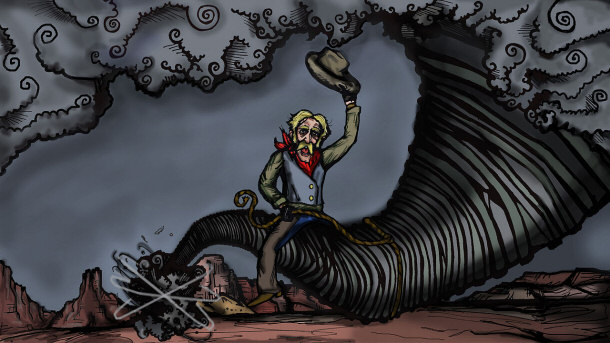
By Maroonbeard
via Wikimedia Commons
There are reported cases of snakes in captivity biting their own tails and
even trying to eat themselves. This action leaves most snake owners incredibly
confused and worried for their pet. Some assume that the reason is a confusing
scent in the tank which makes the snake think that its tail is prey. Pet snakes are
occasionally known to bite owners' hands if the hands are not washed properly.
Especially if the owner starts working in the tank while smelling of snake food. Others assume
that this behavior is due to a malfunction in the snakeís brain due to a vitamin
deficiency. This theory is supported by the fact that these snakes are typically
thrashing around in the tank, turning around on their backs without returning
back onto their bellies, and biting their own tails. Snakes that exhibit this
kind of behavior usually end up dying. To be clear, hoop snakes do not exist and no snake will roll
away from danger by biting its own tail.
Myth 5) Hognose Snakes Spray Venomous Vapor
The hognose snake is pretty good at mimicry. It will copy the defensive act of a
spitting cobra when it's feeling threatened. This means that it raises its body
upright, hisses and puffs up its neck to look as intimidating and impressive as
possible.
Hognose Snake
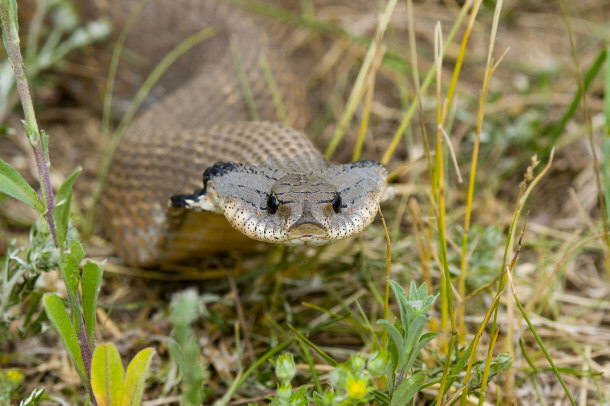
Often, the hissing sound is mistaken to be venonmous vapor being spread.
Hognose snakes donít even have poison and they know it. Thatís why a hognose
snake will turn around on its back and play dead, when it runs out of other
tricks to threaten you with.
Spitting Cobra
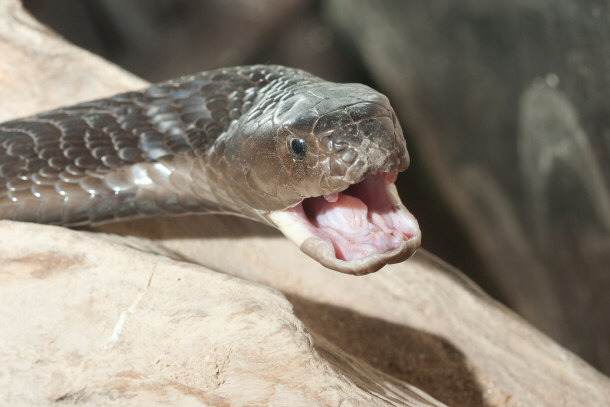
Thereís only one kind of snake that can Ďspití poison in the classical sense,
and it is the
spitting cobra. Spitting cobras aim for the eyes of potential threats like birds
of prey. Some animals will only suffer temporary blindness where as other
targets like humans, can become permanently blind. For
humans, this means to seek out immediate medical attention after being sprayed
by a spitting cobra. Also, the name Ďspittingí cobra is a bit confusing. What
the snake does is not spitting in the same sense as humans do it. Spitting
cobras actually use a single, powerful contraction of their poison glands that
propels venom forward towards their intended target.
Myth 4) All Snakebites are Poisonous
Itís wrong to believe that every snake can effectively
poison you if you are bitten by it. Many snakes do not even have venom glands
and use the act of constriction to subdue, and ultimately kill their prey.
Indian Cobra (Poisonous)
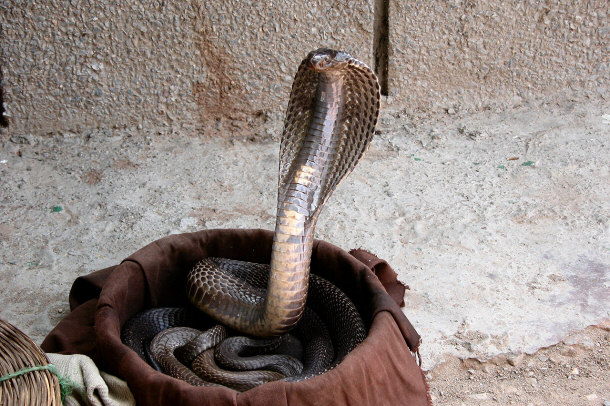
By Qz10
via Wikimedia Commons
Telling these two apart is based on your own knowledge of what species of
snakes live in your geographical region. Since we
already know that the shape of the head will tell you nothing other than that
youíre probably standing way too close to a snake. It is true that snakes can carry
salmonella as well as poison, if theyíre venomous that is.
Fierce Snake (Poisonous)
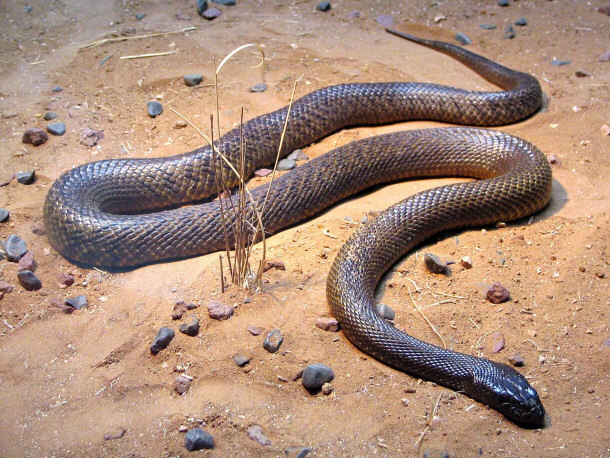
By XLerate
via Wikimedia Commons
Timber Rattlesnake (Non-poisonous)
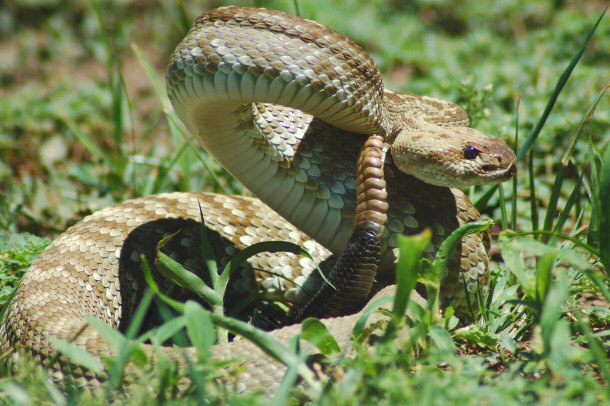
Eastern Diamondback Rattlesnake (Poisonous)
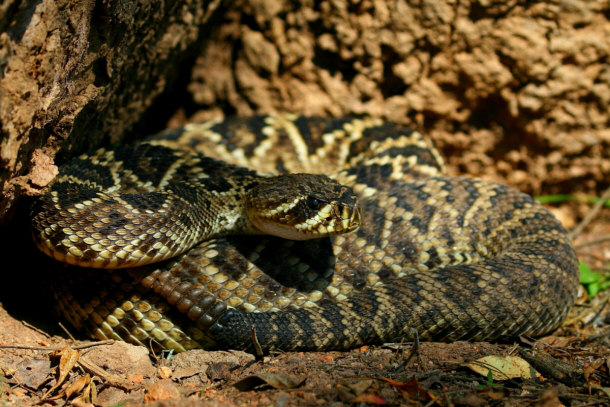
But salmonella is
mainly transferred through feces & urine, and not through bites. Should you be
facing a poisonous snake and are bitten, there is a chance that your life may
not be in jeopardy quite yet. They sometimes issue dry
bites as warnings, as there is no sense in wasting their deadly venom on
something that isnít food.
Myth 3) Snake Charming
The ability to charm cobras is much less of a myth and more of a very
elaborate and well-done performance. Snake Charmers are really well-versed in
understanding the nature of cobras. Snakes can raise one third of their body
length upright. This is a common defensive position for not only cobras but
several other species of snakes. So when a snake is placed in a basked covered with a lid,
the sudden removal of the lid will startle the animal. It will become defensive
and spread its hood to look even more intimidating.
Hindu Snake Charmer with Indian Cobra

The charmer sits far enough away to be outside striking range, which is one
third the snake's body length when standing. The only thing close enough is the
flute the charmer performs on. The snake will focus
completely on this closest threat, while the music played by charmer is not even
relevant.
Snake Charmer
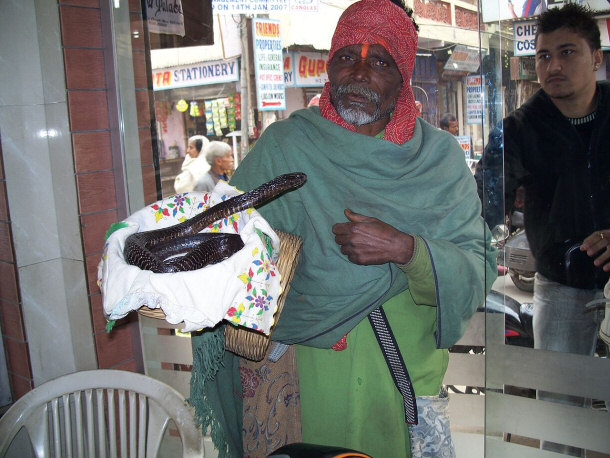
Snakes cannot hear the same way humans do. They focus on
vibrations they can feel, which is also why itís rare to encounter certain
species of snake in the wild. They often flee when they Ďfeelí something larger
than prey coming their way. Even though the animal might be able to feel
vibrations of music, it will be more concerned with the flute itself and follow its
movements. Cobras are defensive animals and are immensely reluctant to strike things when theyíre not
hunting, as itís a waste of venom. Those that are kept in captivity long enough
might have attempted to bite the flute several times, only to learn that itís
hard and defiantly not food.
Myth 2) Sucking Out Poison from a Wound
This myth is one of the hardest ones to crack, and many people strongly believe
that this kind of action can actually save another person's life. It is said that in case of a bite,
you can prevent or slow the poisoning by sucking the venom out of the wound.
What some forget is that the body is able to process chemicals even without
direct consumption, especially through the mucous membranes like the nose and
throat. Wounds in and
around your mouth can allow venom into bloodstream, as well as poison that has
been sucked out of a friend's wound. So if you think you are being a friend and
sucking out snake venom for your buddy, chances are that both of you will have
to go to the hospital or even die, after adhering to this snake myth. Furthermore, the venom
is pumped through the body much faster than it is possible to react and remove
it. In
the case of suffering a poisonous snake bite, place a cold compress on the wound
and avoid any medications and alcohol, as these two things can thin your blood.
California Kingsnake
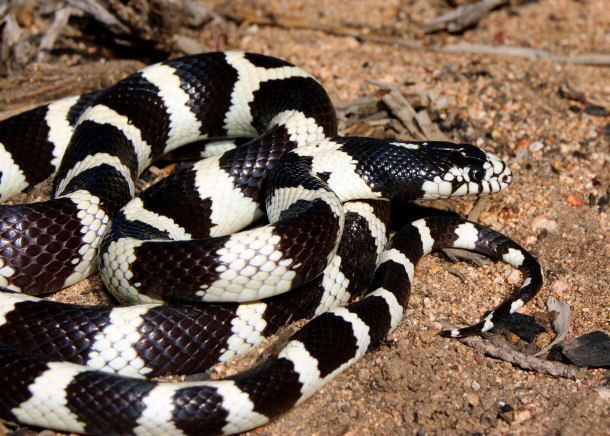
If you want to slow your blood flow, apply a constricting band on the poisoned
limb but donít use a tourniquet due to the increased chance of contracting necrosis. Most importantly and most difficult to
keep together is, donít
panic!
Necrosis Resulting From Poisonous Bite
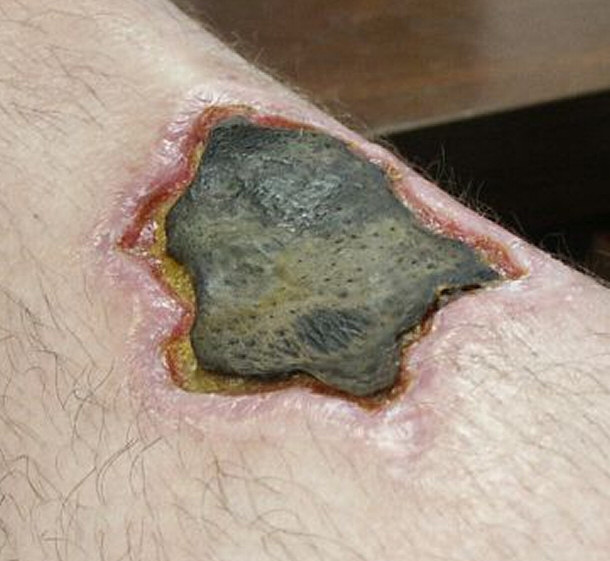
By Jeffrey Rowland
via Wikimedia Commons
Panic speeds up your heart beat and with it your blood flow, which will help
the venom even further along. Get to or have medical help come as quickly as
possible. To get the right antivenin, photograph the offending animal or if it
escaped during the chaos, remember how it looks as best as you can for medical
professionals. As soon as you arrive at the hospital the first thing doctors and
nurses will ask you is what kind of snake you were bitten by, so they can
administer the proper anti-venom. Donít
attempt to kill the animal out of revenge, as this will unnecessarily risk yourself or others even
further.
Myth 1) Snakes Eat People
This last myth, even despite all attempts to debunk it, will most likely
continue to prevail. Many believe that giant snakes can and will suffocate a
grown person in order to eat them. There are some reports that are more or less
accurate of large snakes consuming children or babies. There are also reports,
videos, and pictures of snakes attempting this feat with an adult.
Southern African Rock Python Constricting a Pregnant Female
Goat
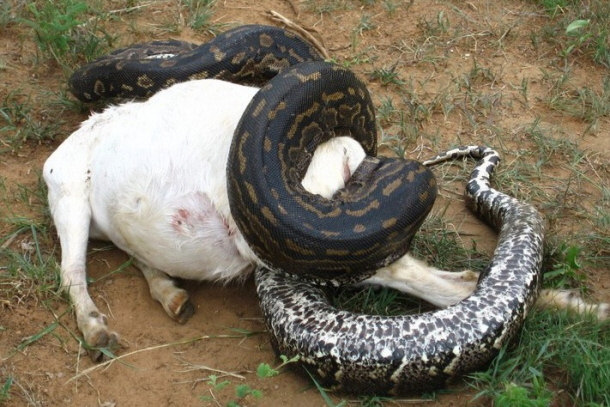
By Materialscientist
via Wikimedia Commons
However, these reports are found to
be unauthentic by herpetologists and other biology professionals.
Although a snake can unhinge its jaw to consume prey larger than themselves,
there is a certain limit to their expansive abilities.
Ball Python Swallowing a Rat
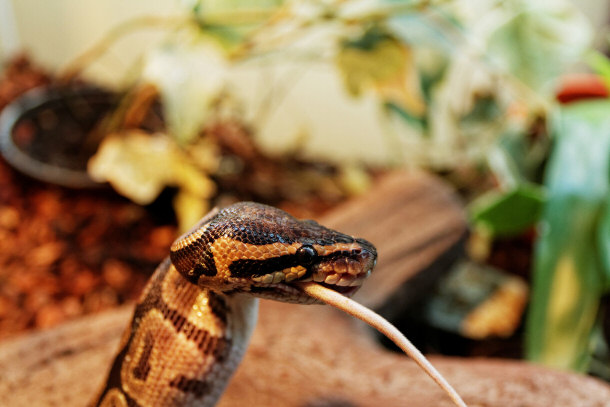
There was a case of a
snake trying to eat an alligator that had roughly the size of an adult. The end
result was that both animals died, and the snake burst because it couldnít
handle the alligator's size.
Final Words
Snakes arenít as inherently scary as they may first seem. Especially after you've learn a little about
their nature and start understanding their nature better. After all, they donít merely exist to
give you goose bumps. Science has long ago discovered the usefulness of snake
venom, and have used it for advances in modern medicine for cancer treatments
and for diabetes patients. Since 1998 there have been two
drugs that are chemically engineered using snake venom as a chemical foundation,
and these pharmacological drugs engineered from snake bites are already on the
market. Both of these drugs are used in the treatment of
coronary
heart disease, and are administered when patients are exhibiting symptoms of
heart disease like chest pains and shortness of breath. So give these scaly guys
the benefit of doubt before deeming them unforgivably evil. They canít help that
they donít have legs!
Nature
Top Lists:
15 Fascinating Facts about the Amazon Rainforest
15 Remarkable Facts About Bacteria
15 Remarkable Facts About Jellyfish
15 Little Known Facts About Elephants
15 Fascinating Facts about Earthquakes
15 Odd And Interesting Facts about Monkeys
Top 15 Myths about Snakes
Top 15 Myths about Horses
Top 15 Creepy Deep Sea Creatures
15 Unexpected Animals That Can Kill You Quickly
Top 15 Spider Myths
15 Beautiful Animals that are Now Extinct
Top 15 Most Amazing Snakes Around the World
15 Fascinating Facts about Snow
Top 15 of the World's Rarest Flowers
10 Most Emotional Animals
15 of the Most Venomous Creatures to Roam the Earth
15 Unusual Animal Defense Mechanisms
15 Unusual and Less Known Uses of Rocks
15 Unique Forest Creatures Less Known To Man
15 Interesting Facts About Time
15 Unknown Parasites You Never Knew Existed
15 Weird Trees Around The World
15 Wild Animals Deadly to Humans
15 Exotic Insects That Are Harmful & Deadly
15 Ridiculous Uses for Gold
Informational:
Preparing for a Disaster
Proof That We Are What We Are!
What is the Meaning of Life?
The Trend and Challenges Facing the Urban World
Creation Narratives and the Evolution Creationist Debate |